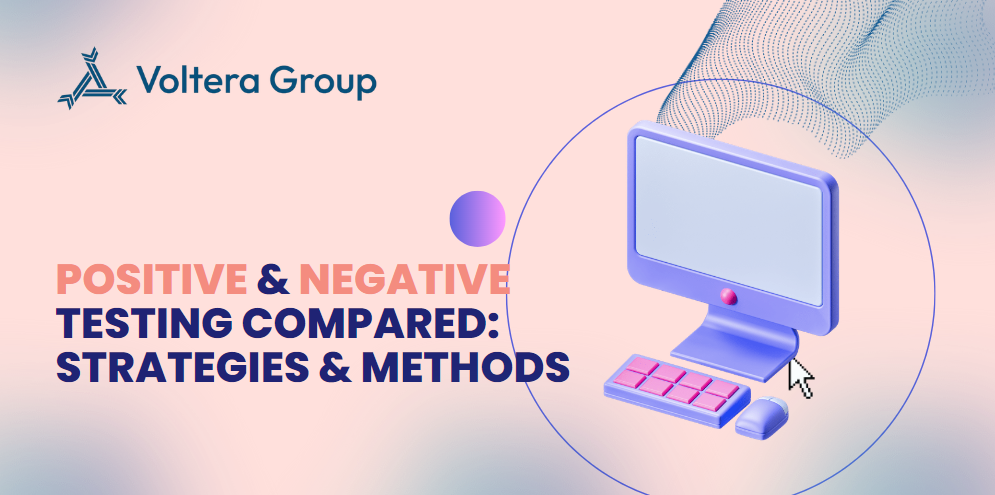In today’s competitive digital landscape, ensuring that software meets the highest standards of functionality and reliability is essential. At Voltera Group, we prioritize a comprehensive approach to Quality Assurance (QA) by combining positive and negative testing methodologies. These are vital in identifying the strengths and weaknesses of software systems to deliver high-quality solutions for our clients.
Our team at Voltera Group is committed to helping businesses optimize their software products by validating expected behaviors and uncovering any potential pitfalls. This balance is crucial to delivering robust, secure, and user-friendly software. In this blog, we’ll delve into how Voltera Group leverages both positive and negative testing to ensure holistic QA for our clients.

Understanding Positive Testing
Positive testing plays a fundamental role in the software development lifecycle. At Voltera Group, we use positive testing to validate the core functionalities of our clients’ systems, ensuring that they perform as expected under normal operating conditions. When we receive valid input data, we test whether the software follows intended paths of execution.
Positive testing focuses on key user interactions and verifies that the software operates as designed. This includes testing data input, processing, and output generation—ensuring a seamless user experience for the end-users of our clients’ applications.
Unit Testing
At Voltera Group, we implement unit testing and integration testing as part of our positive testing strategy:
Unit Testing: We focus on individual components of the software, using industry-standard tools like JUnit for Java or NUnit for .NET to ensure that each unit functions correctly. This approach allows our team to detect and resolve issues early, providing a solid foundation for further testing phases.
Integration Testing: We ensure that all components of a system work well together through integration testing. Our testers use continuous integration (CI) tools to validate that different system modules collaborate seamlessly. This step is crucial to ensure the overall integrity of the software product.
Integration Testing
Negative testing is equally important in achieving comprehensive QA. At Voltera Group, we use negative testing to simulate adverse conditions, such as invalid inputs or unexpected user behavior. The goal is to assess how the software reacts to edge cases and potential failures, ensuring robustness under all conditions.
Negative testing at Voltera Group focuses on identifying boundary conditions, security vulnerabilities, and error-handling mechanisms. This proactive approach ensures that the software we develop is secure, stable, and reliable—ready to handle real-world scenarios where users might make mistakes or behave unpredictably.
Understanding Negative Testing
Negative testing is equally important in achieving comprehensive QA. At Voltera Group, we use negative testing to simulate adverse conditions, such as invalid inputs or unexpected user behavior. The goal is to assess how the software reacts to edge cases and potential failures, ensuring robustness under all conditions.
Negative testing at Voltera Group focuses on identifying boundary conditions, security vulnerabilities, and error-handling mechanisms. This proactive approach ensures that the software we develop is secure, stable, and reliable—ready to handle real-world scenarios where users might make mistakes or behave unpredictably.
Our Negative Testing Methodologies
We employ methods like boundary value analysis and error guessing during our negative testing phases:
Boundary Value Analysis: We test the system’s behavior at the edge of its input ranges to ensure stability and proper error handling.
Error Guessing: Our team uses its expertise to hypothesize potential error scenarios and tests how the software handles them. This helps uncover unexpected issues that may not be immediately apparent during normal operation.
Implementing a Balanced Testing Approach
Voltera Group’s QA process is centered around delivering value to our clients through comprehensive testing methodologies. Here’s how we achieve that:
Clear Testing Strategy: We develop structured testing strategies tailored to our clients’ specific project goals and timelines, ensuring efficient resource allocation.
Automation: Automation is key to improving efficiency in both positive and negative testing. We use tools like Jenkins and Travis CI to automate regression tests, ensuring that new changes don’t break existing functionalities.
User Experience Focus: Our testing approach is always guided by the end-user experience. Positive testing ensures the application meets user expectations, while negative testing guarantees reliability even in adverse scenarios.
Continuous Testing and Improvement: Voltera Group integrates continuous testing into the development lifecycle, allowing for immediate feedback and faster issue resolution. We regularly review and update test cases to reflect changes in the application, ensuring sustained high-quality software.
Common Testing Scenarios
At Voltera Group, we often encounter the following common scenarios in both positive and negative testing:
Positive Test Scenarios: Validating core functionalities like user login, data validation, and performance testing under normal operating conditions.
Negative Test Scenarios: Testing with invalid data inputs, boundary conditions, and verifying error-handling mechanisms in response to unexpected errors.





